Rapid developments in the world of mirrorless stills cameras and stills/video convergence are changing the industry’s landscape. Even if you have no interest in video you should be paying attention to the epic commercial battle that is rapidly evolving, because it’s likely to have profound effects on the tools and toys that we all use in the years ahead.

Do Not Enter. Toronto, November, 2010
Panasonic vs. Sony – The Epic Battle
Two of the Goliaths of the global electronic industry are Sony and Panasonic. These companies are historical competitors in everything from TVs, to stereos to rice cookers. They have long been the industry’sBig Twowhen it comes to semi-professional and consumer video.
But neither company had any real history in still photograph until mid-decade, when Panasonic along with Olympus launched the Four Thirds camera system (2003), and Sony purchased Konica / Minolta (2006). Then in 2008 momentum started to build with the introduction of Panasonic’s mirrorless Micro Four Thirds system, and in early 2010 Sony’s NEX mirrorless cameras. 2010 also saw Sony’s mirrorless A33 and A55 Alpha mount systems.
Of course by now (late 2010) every DSLR, DIGICAM and cell phone has not only Live View, but HD video as well. The technology has converged– at least– if not the use of it.
It should be borne in mind that both Panasonic and Sony are vertically integrated companies, which own their own semiconductor and sensor design and fabrication facilities. This is an important factor in understanding what is currently driving this industry, as we’ll see in a moment.
The Future Ain’t What it Used to Be
Canon, with the 5D MKII, was the originator of the large sensor pro video craze. There were still cameras that could do video prior to this model, but its full frame 35mm sensor and interchangeable lenses were a revelation to advanced amateur and professional video makers. Why? Simple– shallow depth of field.
Professional cameras used in Hollywood as well as film and television production centers around the world typically use so-called Super 35mm. This format is somewhat larger than the Four Thirds still format.(Corrected). It provides relatively shallow depth of field, which is highly desirable for thelookthat is motion picture film. Shallow DOF allows the narrative film maker to isolate the main subject (character) from his or her environment and is a great aid in story telling.
Video, on the other hand, is almost incapable of thislookbecause the sensors used in video cameras are very small, and therefore for any given image size have much deeper DOF.
With the 5D MKII film makers fell all over themselves because of the shallow DOF available. This model, as well as just about every other video capable DSLR, are really quite terrible video cameras in every respect other than their shallow DOF. I’ve written about this on these pages previously, so there’s little point in belabouring the issue. Nevertheless everyone from feature film makers to multi-million dollar per-episode TV shows (House) adopted the video DSLR for at least some of their production needs.
Lenses
Before going further, we need to consider the question of lenses. While the camera industry has become just another facet of the consumer electronics industry, a camera’s optics (stills or video) are a significant factor, not to mention a profit center for the manufacturers.
Both companies therefore partnered with historical giants of the lens industry; Panasonic with Leica, and Sony with Carl Zeiss. Sony also obtained a highly regarded optical legacy as part of their acquisition of Minolta.
Manufacturers Wake Up
Most camera makers continue to build mediocre video capability into their still cameras. Why? Because they can. It costs them next to nothing. A DSLR with live view and some appropriate firmware becomes a video camera. Go for it, if you wish.
But Sony and Panasonic are also in the professional and semi-pro video camera business. They looked at Canon’s success in the movie / TV industry with the 5D MKII and were faced with a quandary. They could easily make large sensor video cameras based on their DSLR technology, but what would this do to their traditional pro video products?
But capitalism has its greatest strength when commercial competition becomes inevitable. No one wanted to be the first to blink, but slowly over the past year or so both Sony and Panasonic put their toes in the water, and now the flood gates are opening (if you’ll excuse the mixed metaphor).
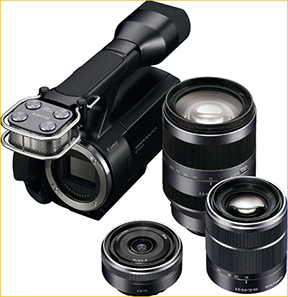
Sony NEX VG10
First out of the block was Sony with its VG10 video camera, based on the new NEX series. These use an APS-C sized sensor. As I noted inmy initial review, this isn’t that exciting a video camera. It had a lot of potential, but clearly Sony was nervous about cannibalizing its pro video cameras, so they clearly crippled the camera’s capabilities so that it wouldn’t be a threat.
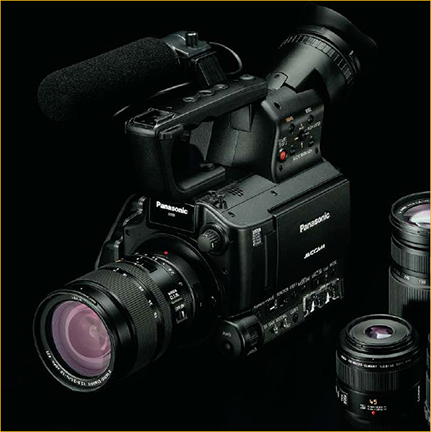
Panasonic AF100/101
But then shortly thereafter Panasonic announced theAF100 / 101. This camera broke the log jam. A high specification AVCHD encoder, full semi-pro video features, and a Four Thirds sized sensor with a Micro Four Thirds lens mount able to take just about any lens, including PL mount, Leica M mount. Zeiss, etc. The icing on the cake was an announced price of under US $5,000. Now you’re talking!
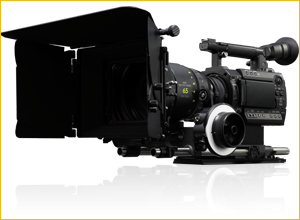
Sony’s immediate rejoinder was its pro-gradeCineAlta F3. This uses PL mount lenses and a Super 35MM sized sensor (similar in size to APS-C, and somewhat larger than Four Thirds), but is a bit out of our league in terms of price (US $23,000) and specification. Nevertheless, it was a signal that Sony had bit the bullet and decided to play.
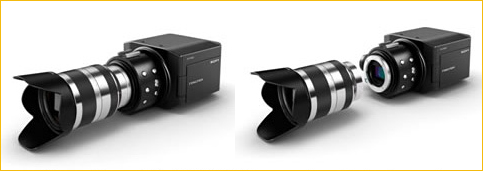
Sony Super 35 NEXCAM
Surprisingly, and showing that they aren’t simply willing to compete by halves, not long afterward, in late November 2010, Sony announced a Super 35 NEXCAM camera that uses their NEX E lens mount and a top of the line AVCHD codec. This is the camera that the VG10 should have been.
FUD – Fear, Uncertainty and Doubt
There is no word on the price (rumoured to be sub $7,000) of theSony Super 35 NEXCAM, exact specifications, or model name. Delivery is simply mentioned as mid-2011. So, what is this about? Why announce a product more than half a year before it is due, and while it’s still in the development stage. This simply isn’t Sony’s usual MO.
If you ever worked in the mainframe or mini computer industry you will know what I mean when I use the phraseFear, Uncertainty and Doubt. FUD was IBM’s tactic whenever a competitor announced a new product due to ship in a short while. IBM might not have anything even close to ready to compete, but they would announce that they had something coming, and would detail some rough specs and a delivery date.
That was all it took to derail their competitors from grabbing too much market share. Since “No one ever got fired for buying IBM,” as the well known phrase went, simply knowing that there was something coming fromBig Bluewas enough to cost competitors sales, while many customers waitied to see what the guys in Armonk had coming for them.
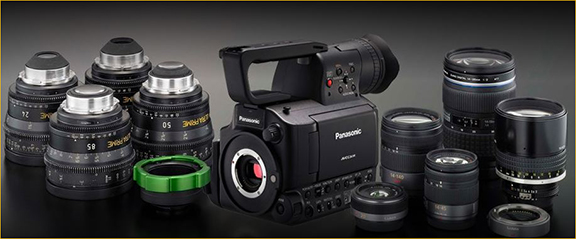
Which brings us back to today and the nascent large sensor video camera market. Panasonic is about to ship theAF100 / 101. As this is being written in mid-November 2010 this exciting new camera is scheduled to start shipping within a few weeks. If initial commentary and response is anything to judge by the AF100 will be a resounding success for Panasonic, especially at its aggressive price point of under $5,000.
Sony’s CineAlta F3 will be available soon as well, but at 4X – 5X the price of the AF100 it is targeted at a much more elevated market segment than the Panasonic.
All of this makes sense given the two company’s market positions. Sony is a major player in the broadcast industry while Panasonic’s involvement in video stops at the top end of the indy / prosumer market. Sony has a lot more to lose than does Panasonic by the large sensor interchangable lens video revolution.
So What?
If you are involved professionally or personally in the video segment of the market I assume that the above will have been of some interest – pointing out some of the exciting products that are coming our way in the weeks and months ahead.
Needless to say, the traditional small-sensor pro and semi-pro camcorder business is about to be whacked up-side the head. While deep DOF small sensor camcorders are desirable for some documentary work, anyone doing narrative movie production at any level – from Hollywood films to New York TV shows to Indy producers are going to fall all over themselves over the shallow DOF capability of this generation of large sensor interchangeable lens cameras.
And while the massively shallow DOF of the full frame Canon 5D MKII isoh soattractive, many film makers find it hard to work with. It’s actually too shallow for day-to-day shooting, and if one stops down to reduce DOF then one needs to add more light to the scene, which is contrary to the gestalt of current film making, let alone today’s constrained production budgets.
The smaller (but still large in cine terms) APS-C and Four Thirds sensors are at the sweet spot; small enough to allow shallow DOF when desired, yet not so shallow that a moderate aperture presents lighting issues. Indeed the Four Thirds sensor’s size is isn’t that much smaller than traditional 35mm motion picture film.Thus we will have both Sony and Panasonic with their new video cameras having sensors aimed at the DOF sweet spot.
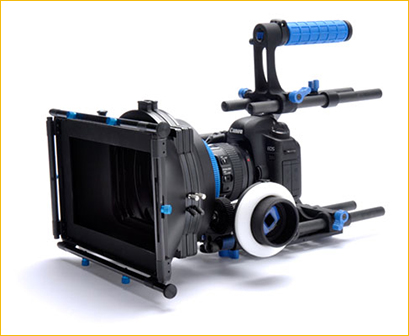
All of the begs the question – is there room for video DSLRs in this new brave new large sensor video camera world? The answer is likely bothyesandno. At the pro level there will always be those cinematographers who love the small size / big picture that a DSLR offers when shooting video. But for anything other than shooting in incredibly tight quarters, DSLRs make truly terrible cine cameras.
To be usable they need a range of handling accessories that increases their bulk to that of a proper video camera. They also are completely lacking in terms of obligatory video features such as built in ND filters, zebras, peaking, under and over cranking, live EVFs, wave form monitors, and the like.
I therefore think that over the next year or so the video DSLR revolution, begun by Nikon with the D90 and brought to a peak by the Canon 5D MKII, will have run its course. Naturally all DSLRs will continue to offer ever-improving video capability, but they will essentially remain stills cameras that can (Oh, by the way) shoot video, while the new generation of large sensor video cameras such as the AF100 and Super 35 NEXCAM become the tools of choice for Indy film makers and other budget-oriented producers and cinematographers.
At the high end we will have Sony, with its new CineAlta F3 and successors. Whether Panasonic will decide to play in this more rarified segment remains to be seen. This is traditionally Sony CineAlta, Arri Alexa, and RED territory.
What About RED?
Speaking of RED, where’s theScarlet? This is a question that we’ve been asking for two years now (a period of time equivalent to two geological epochs in this industry).
RED has cemented a solid position for itself in commercial and theatrical production with the RED One and now the Epic. But its price point when equipped for production is not for the light of wallet, and is in the Alexa and CineAlta region, not the sub-$7,000 strata where the new Panasonic and Sony cameras that we’re interested in habitate.
The Scarlet was supposed to fill that ecological niche, but it remains MIA, and some pundits believe that it will be still-born, especially now that the Asian giants have been given enough time to awake from their slumbers.
Compression. Toronto, November, 2010
Where Do We Go From Here?
Trying to forecast this industry (stills and video) is a mugs game. Not even the major companies with their marketing gurus and product specialists can accurately see more than a couple of quarters into the future. The rate of change of both technology and the marketplace is simply too fast forFive Year Plans, or even two years.
Clearly the revolution that started in photography some dozen years ago with the switch from film to sensor, continues to evolve unabated. During that period, just a decade or so, the video industry has seen the transition from tape to solid state, from SD to HD, and now from small sensors to large sensors. RED has shown that professionals want and need raw video, just as still photographers do, and its only a matter of time, now that the new generation of video cameras use much the same sensors as those in DSLRs, that raw video will become available from the major Asian players, not just Ari and RED.
Not long ago we thought that the revolution would come in the form of still cameras that could also shoot video. We weren’t wrong in that. But still photographers aren’t really interested in shooting video.Videomakersare interested in shooting video, and they want the best tools that they can get at the lowest possible price.
Till now the video DSLR has been their choice because it’s been the only game in town at the sub-$7,000 price point. But that changes as of now, and it’s likely that a year or two from now we’ll see very few DSLRs being used in video production.
But, Panasonic and Sony are sitting in a commanding position when it comes to stills / video convergence. Sony has its E series lenses used on NEX stills and video cameras, and Panasonic its Micro Four Thirds lenses shared with its G series stills cameras and new AF series video cameras. Because of their short back focus distance (due to the mirrorless stills design) both company’s stills and video cameras can also take a wide range of legacy lenses from many manufacturers, including the all-important PL mount from the movie industry.
It therefore seems that the decision by both Sony and Panasonic to pursue the mirrorless stills/video convergence market was a sound one, well thought out in advance, in broad stokes if not in specifics and timing. Both companies stand to benefit from this foresightedness.
What About Canon and Nikon?
Of course Nikon and Canon are two giants of the traditional DSLR industry. Neither is as diversified as Sony and Panasonic in consumer electronics, but Canon has long been a player in prosumer and prosumer video, as well as broadcast video optics. Nikon has world-class lenses, but has never been a player in the video world at any level. (Nikon used to make some pretty cool Super-8 film cameras though). Both companies also have sensor design capabilities, but of the two only Canon owns its own sensor fabrication plant.
Curiously, though Canon stumbled into becoming the leader thus far in larger sensor video DSLRs, and Nikon has been introducing video capable models at a fast clip as well, neither company has yet seen fit to release either a dedicated large sensor video camera or a mirrorless DSLR (for lack of a better name).
Whether this is because they are afraid of cannibalizing their own high margin DSLR market, or some other reason, the fact remains that the fastest growing market segment at the moment are mirrorless convergence cameras, and neither of the two industry stalwarts are playing (yet). It will be interesting to see if they allow Panasonic and Sony to continue to eat their lunch in this segment.
November, 2010
You May Also Enjoy...
Plaza de Armas
Nocturne in C minor©Miles HeckerCLICK ABOVE IMAGE TO SEE GOOGLE MAP LOCATION SEASONS The Plaza de Armas is both the cultural and spiritual center of

